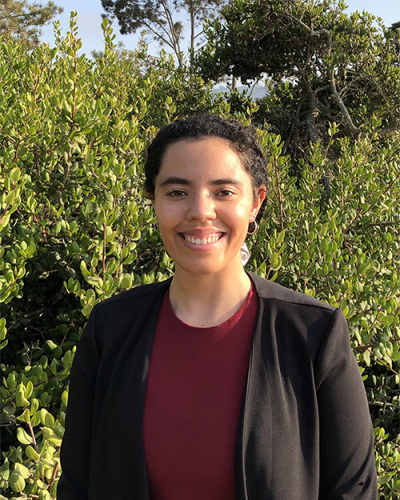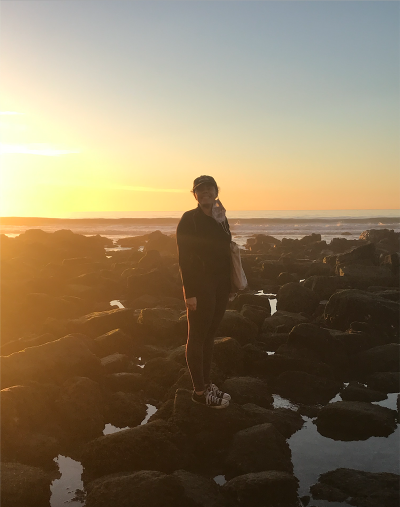Karina Halliman is an undergraduate student at UC San Diego, where she is studying ecology, behavior, and evolution as part of the Environmental Systems (ESYS) Program, which is administered by Scripps Institution of Oceanography. Originally from Littlerock, Calif., Halliman decided to pursue higher education at UC San Diego based on its reputation for world-class research. In the summer of 2020, Halliman participated in the Scripps Undergraduate Research Fellowship, or SURF program, and studied how microplastics travel through the Western Antarctic Peninsula food web. This research was done in the lab of her advisor, Scripps biological oceanographer Maria Vernet, with mentorship from Scripps PhD student Tammy Russell. Halliman has continued working in the Vernet Lab as she prepares to graduate from the ESYS program.
explorations now: Why did you choose to attend Scripps?
Karina Halliman: UC San Diego was my first choice for college partly because of the location, I liked that the school was far enough away from home but also close enough to still feel nearby. I was born and raised in Southern California and absolutely love the sunshine and sunsets. In addition, UC schools prioritize their roles as research institutions and so taking part in research was a goal I always had since the beginning of my first year. I first applied as a psychology major because of my interest in the subject after being introduced to it in high school. Then after learning about climate change from taking AP environmental science in high school I felt the urge to learn more about it, and was what led me to Scripps. I got lucky that my interests coincided with Scripps.

en: What are you researching at Scripps?
KH: This past summer I researched how microplastics travel through the Western Antarctic Peninsula food web and possible bioaccumulation in higher trophic level species by using ecosystem modeling as part of the Scripps Undergraduate Research Fellowship. Little research has been done on how the microplastics get into or move through the food web, especially along the Western Antarctic Peninsula, a region that is also under the pressure of immense warming from climate change. Understanding microplastic bioaccumulation in higher trophic level species will aid in understanding the prospective impacts of human plastic pollution.
I worked closely with PhD student Tammy Russell throughout the summer and have continued working with her this year. I am currently conducting an exploratory analysis of changes in seabird density over time and latitude along the U.S. West Coast with the help of the Triton Research and Experiential Learning Scholars (TRELS) program. I have been practicing my R coding skills and learning how to make maps in ArcMap. Seabirds are integral species within ocean ecosystems. As top marine consumers, seabird population dynamics are inextricably tied to the health of the marine ecosystem and can serve as important ecosystem indicators.
en: How did you become interested in science and your field of study?
KH: My journey to where I am now has taken many detours into new spaces and interests. I first became interested in research when I took AP psychology my junior year of high school where I was fascinated by the experiments people had done to better understand ourselves as humans. Then I took AP environmental science my senior year where I received an introduction to environmental processes and challenges. Coming into college my heart was set on becoming a veterinarian to work with endangered species to reduce the threats they face. But then through taking a wide range of classes in college, I learned how interdisciplinary environmental challenges truly are and I realized then what I really wanted to do was to understand the wider system and interactions between animal species, humans, and cultures. After consideration and exploration, I combined my two interests of research and conservation and eventually found myself doing research on anthropogenic effects on the earth’s ecosystems and environments.

en: What’s life like as a Scripps student? Describe a typical day.
KH: Right now during a pandemic my typical day is filled with Zoom classes, meetings, and coding in R. To take a break, I like to take walks outside in nature and play my favorite game, Animal Crossing New Horizons.
en: What’s the most exciting thing about your work (in the field or in the lab)?
KH: I spend a lot of time doing data manipulation and analysis. I get excited when my graphs come out how I want and especially when my code works right after many error messages. Creating something brings me joy especially after struggling with a code for a while.
en: Are there any role models or mentors who have helped you along the way?
KH: I have had the pleasure of getting to work with and know Tammy Russell. She has shown me what a good mentor is as well as the qualities to look for in a future advisor. She pushes me to think critically and to put myself out there for opportunities. Tammy checks in on how I’m feeling and reminds me to take breaks for myself. Her empathy is matched by her confidence in others; she has made me feel as though nothing is beyond my grasp and therefore she is my role model.
en: What are some of the challenges you face as a student?
KH: One major challenge that has affected me as a student was in January of 2020, I was diagnosed with Chronic Myeloid Leukemia, a cancer that affects my white blood cells and causes them to grow uncontrollably. I had to drop classes the quarter I was diagnosed and resulted in me taking an extra year of schooling to finish my goal of being the first person in my family to finish college. It was the toughest experience I have had to endure. With modern medicine practices, the once deadly leukemia became something I can live with and hopefully one day reach remission. I take it one day at a time and I believe why not take advantage of every opportunity wholeheartedly because life is too short to not pursue my passions.
en: What are your post-graduation plans?
KH: From my experience, as a SURF fellow, I learned about graduate school, gained exposure to research, and solidified that I want to obtain a PhD. Before I pursue my aspiration, I want to explore different aspects of scientific research to determine what exactly interests me before jumping into a PhD program.
Find Karina on Twitter @KurlyKarinaH and on Instagram @karina.ha_. You can also find the Vernet Lab at the username @FjordPhyto on Twitter, Instagram, Facebook, and YouTube.